
I missed an opportunity. You may recall the retrofit I did in 2022 to get faster hot water at three of my fixtures. It made a huge improvement, but it could have been even better. But before I go there, let me give you some background information and tell you about the hot water distribution I’ve been working on for my basement renovation. And be sure to watch the video down below, too.
The most common answer isn’t always the best
If you search online for information about how to get faster hot water, most of what you’ll find is about recirculating pumps. Yes, they can get you fast hot water, but at a cost. If you go with a pump that keeps the hot water recirculating continuously, you’ll see a significant jump in your energy bills. It takes energy to run the pump, and it also causes the water heater to run more because of the heat loss from the pipes. You can reduce the cost by putting it on a timer, but it still can be a lot.
A recirculating pump that operates only on demand is way better. (See the D’MAND pumps and controls for details.) This pump moves the hot water through the system when given the signal to operate. A switch or push button in a convenient place normally is how you make this work, but it could be triggered by a motion sensor as well. The push button type can reduce pump runtime by 98% and heat loss by 90% compared to a continuous recirculating pump.
But even with the demand type of recirculating pump, you have another mechanical system that uses energy, needs maintenance, and can break down.
Weekly Newsletter
Get building science and energy efficiency advice, plus special offers, in your inbox.
The key to faster hot water
The key to faster hot water without having to add more mechanical systems is to get smart about your hot water distribution system. You can see my previous articles on this topic for more details, so I’ll cut to the chase here:
The key to faster hot water is shorter pipes with smaller diameters.
Another way to say the same thing is:
The key to faster hot water is having as little water as possible between the water heater and the tap.
That’s why I changed the hot water distribution for three fixtures in my house in 2022. And it works great! The kitchen faucet, for example, had about 80 ft. of mostly 3/4 in. copper pipe. It took 2 minutes and 40 seconds to get hot water. Since the retrofit, hot water arrives at the kitchen sink in about 30 seconds. That’s a huge improvement!
But I missed an opportunity because I wasn’t thinking clearly about the whole path of hot water.
My basement hot water improvement
When I did my first retrofit, I made two mistakes. Yes, I did get a lot of improvement by reducing the overall length of the kitchen piping from 80 ft. to about 36 ft. and the diameter from mostly 3/4 in. to 3/8 in. But my first mistake was not considering where to insert the manifold into the distribution system. I placed it up high, near the tee that sent the hot water to the other fixtures.
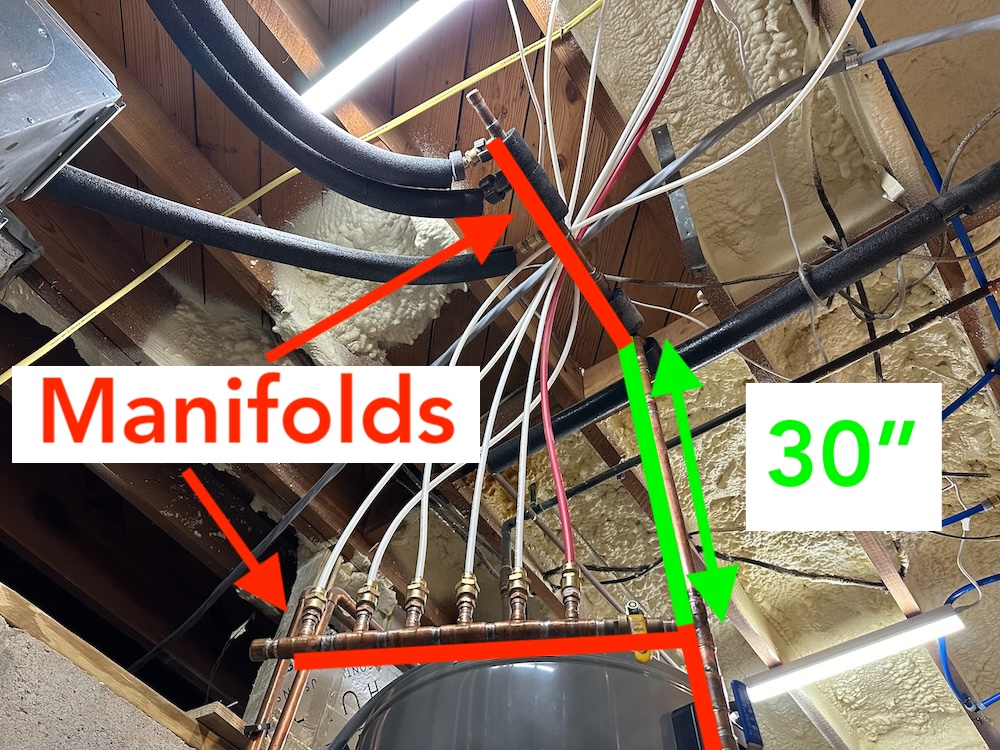
As you can see in the annotated photo above, that location is 30 in. above where I put the new manifold. There’s another almost 30 in. of 3/4 in. copper pipe below the new manifold. For that size pipe, that means there’s an additional cup of water in each of those 30 in. sections. In the 36 ft. of 3/8 in. PEX tubing that goes to the kitchen, there’s about 3 cups of water. So, I increased the amount of water I have to push out by a third by putting the manifold so high.
The other mistake I made was making the manifold so long. The new manifold is about the same length as the old one, but it has twice as many branches. By putting extra length in the old manifold, I also put extra water in there that had to be pushed through before hot water could arrive.
![Larry Weingarten likes to put the hot water manifold right at the water heater outlet [Photo courtesy of Larry Weingarten]](https://www.energyvanguard.com/wp-content/uploads/2024/10/hot-water-manifold-top-of-wh-2-med.jpg)
Here’s a video about my hot water distribution system. It might give you a better idea of what’s going on here:
Pay attention to pressure drop
Smaller pipes or tubing means higher velocity and more pressure drop. To make this work, you have to know that the pressure drop in your new system won’t be too much. Plumbing codes generally say you need a minimum pressure at the tap of about 20 pounds per square inch (psi). If you’re starting with 40 psi and have a 25-psi drop, you’re not going to be happy with the water coming out.
The good news is that for PEX (and other plastic pipes) you can run the numbers through the Plastic Pipe Calculator to find out how much pressure drop you’ll get. In my longest 1/4 in. run, the calculator says I have about a 30-psi pressure drop. Our incoming water pressure is over 100 psi and reduced to 60 psi in the house. (See my last article for more on that.) So, the 30-psi pressure at the tap is fine. And actually, I don’t even notice a difference between the hot water coming through the small tubing and the cold water coming through 3/4 in. and 1/2 in. copper pipes.
Quarter-inch tubing is NOT for long runs or houses with low incoming pressure. You have to have good pressure, short runs, and low flow rates. It works for single low-flow fixtures up to about 25 ft. of length. That’s why for my kitchen and its 36 ft. run, I used 3/8 in. tubing.
But can it pass a plumbing inspection?
We just had the plumbing rough-in inspection for our basement renovation. Did the inspector approve the quarter inch PEX tubing? If you go through the prescriptive compliance path of the International Residential Code (IRC), it’s not allowed. Here’s the language in the 2021 IRC:
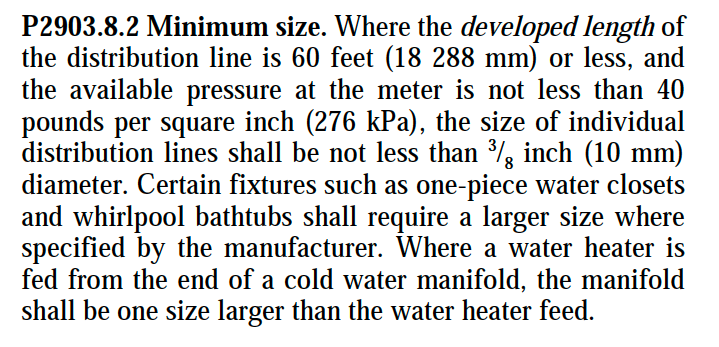
But in this case, our building official approved it. When he saw the white tubing, he asked, “Do you know why the plumber used 3/8 in. for the hot water?”
“That’s not 3/8,” I said. “It’s quarter inch.” Then I explained briefly that it was for faster hot water, and he was satisfied with that. I was prepared to explain a lot more but didn’t need to. If that had failed, I would have gotten a letter from a licensed engineer.
There you have it. Shorter, smaller pipes are the key to faster hot water. Pay attention to all of the pipes, though. And if you’re going to go with 1/4 in. tubing, be prepared to support your case.
Allison A. Bailes III, PhD is a speaker, writer, building science consultant, and the founder of Energy Vanguard in Decatur, Georgia. He has a doctorate in physics and is the author of a bestselling book on building science. He also writes the Energy Vanguard Blog. For more updates, you can follow Allison on LinkedIn and subscribe to Energy Vanguard’s weekly newsletter and YouTube channel.





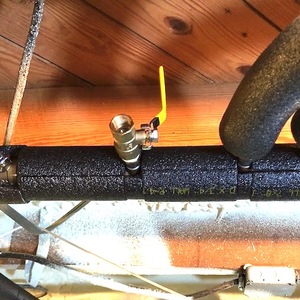
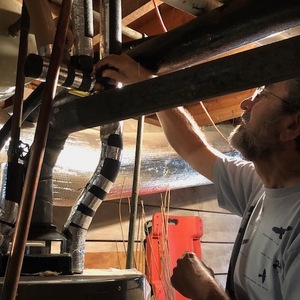
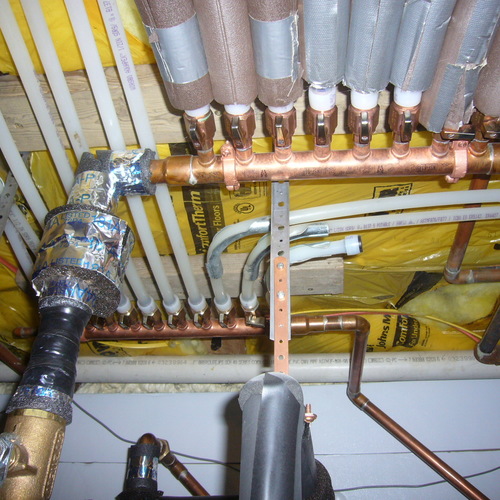
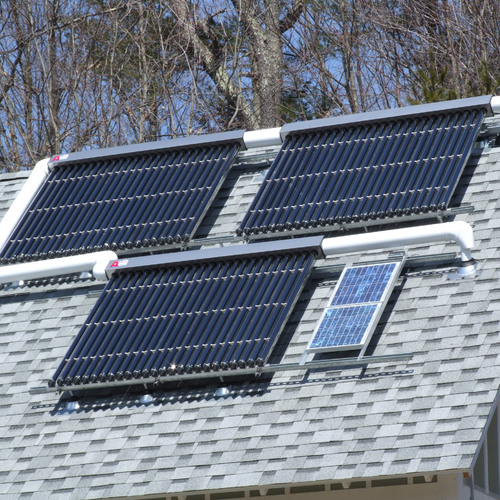







5 Comments
Great writeup Allison, and thanks for being a guinea pig for the community’s benefit!
I may be using the calculator wrong, but for a 1.2gpm lav faucet with ¼” Pex the velocity came to 8.4fps. I don’t know what kind of Pex you used or the fixture flow rates, but per this PDF https://www.rehau.com/downloads/497782/pexapipingsystemspressurelosstables-855681-rehau.pdf “Flow velocity above 8 fps (2.5 m/s) might result in excessive pressure loss, noise or erosion of the system components.”
I’d be curious to hear if erosion is something you’re concerned with and whether your math came out differently. Sharing an office with a plumber, I get to hear about all sorts of niche issues, including a few Pex failures from erosion due to continuous recirc systems, so I’m perhaps overly concerned…
What is your new and improved time for hot water at the kitchen sink?
On a 4 bedroom 2-story rental of 1960s vintage I was unable to replace pipes beyond the cellar. I first went with a tankless water heater when the traditional heater failed. The lag time for hot water in the upstairs bathrooms was horrible. Given that a family of 5 or more might be living there, I was stuck with wanting to maintain flow rates when 2 bathrooms and the kitchen were busy. I increased the feed to the water heater to 3/4” copper and used the same to the first major T. I was stuck with 1/2” copper to the kitchen and to the second floor. On the second floor I installed a small auxiliary electric water heater of about 4.5 gallons being fed from the tankless heater in the cellar. I did the same for the kitchen using a 2 gallon unit. The hot water lag time was greatly reduced. It’s not a perfect solution but a great improvement.
I did your manifold design at my last house when I installed the HPWH. 3/8” pex insulated to each fixture. Hot water delivery time was greatly increased. I’m preparing to do the same on an ADU I’m finishing at our new house. 1/4” seems small, and maybe more difficult to find the fittings for?
Great writeup Allison, and thanks for being a guinea pig for the community’s benefit!
The premier Quranic, Arabic, and Islamic Studies education destination. With a strong presence in London, UK, and managed from Egypt, we offer comprehensive classes for children and adults worldwide. Our esteemed instructors, certified and native Arabic speakers from Al-Azhar University, ensure a high-quality learning experience. Explore our offerings at Ayat Academy and embark on your knowledge and spiritual growth journey with us.
Log in or create an account to post a comment.
Sign up Log in